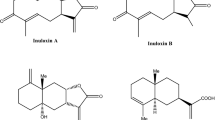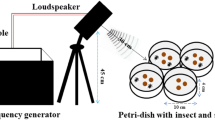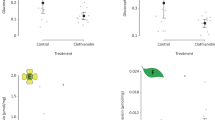Abstract
Artificial seeds offer an important method to assay the bioactivity of natural and synthetic compounds against insect larvae that develop within the cotyledons of seeds. Here, the efficacy of artificial seeds as a mechanism to deliver bioactive compounds to larvae of the bruchid beetle, Callosobruchus maculatus, was compared to that of black-eyed beans that had been imbibed with the same bioactive compounds: malachite green or the methanolic extract of neem (Azadirachta indica). Females laid an equivalent number of eggs on control artificial seeds in comparison with black-eyed beans, although egg-to-adult survival on artificial seeds was reduced. Manipulation of the hardness of artificial seeds influenced female oviposition decisions, with more eggs laid on the harder seeds, although seed hardness had no effect on egg-to-adult survival. Incorporation of neem extract or malachite green into the artificial seeds resulted in 100 % larval mortality, while larval mortality on seeds imbibed with neem extract or malachite green was between 50 and 70 %. This suggests incorporation of toxins into artificial seeds, produces a more sensitive assay of compound toxicity in comparison with the method of imbibing seeds and offers a useful method to study of seed–arthropod interactions.

Similar content being viewed by others
References
Akintobi DCA, Salau AW (2009) Assessment of the resistance of pod wall of cowpea (Vigna unguiculata) to Bruchids. Niger Agric J 38(1):49–56
Bannakan I, Hormchan P, Wongpiyasatid A, Engkakul A (2007) Effects of α-amylase inhibitor on mungbean weevil, Callosobruchus maculatus, in vivo and in vitro and on barley malt α-amylase in vitro. Witthayasan Kasetsart 41:451–460
Bruni R, Guerrini A, Scalia S, Romagnoli CS (2002) Rapid techniques for the extraction of vitamin E isomers from Amaranthus caudatus seeds, ultrasonic and supercritical fluid extraction. J Phytochem Anal 5:257–261
British Standards Institution (2005) BS EN ISO 6507-1:2005: Metallic materials—Vickers hardness test—Part 1: Test method. London, British Standards Institution, pp 1–19
Coelho MB, Macedo MLR, Marangoni S, Silva DS, Cesarino I, Mazzafera P (2010) Purification of Legumin-like proteins from Coffea arabica and Coffea racemosa seeds and their insecticidal properties toward cowpea weevil (Callosobruchus maculatus) (Coleoptera: Bruchidae). J Agric Food Chem 58(5):3050–3055
Crawley MJ (2002) Statistical computing: an introduction to data analysis using S-plus. Wiley, Chichester
Don-Pedro KN (1989) Mode of action of fixed oils against egg of Callosobruchus maculatus (F.). Pestic Sci 26:107–115
Duranti M, Gius C (1997) Legume seeds: protein content and nutritional value. Field Crops Res 53:31–45
Eady PE, Wilson N, Jackson M (2000) Copulating with multiple mates enhances female fecundity but not egg-to-adult survival in the bruchid beetle Callosobruchus maculatus. Evolution 54(6):2161–2165
Finnie C, Svensson B (2009) Barley seed proteomics from spots to structures. J Proteomics 72:234–315
Girish K, Bhat SS (2008) Neem—a green treasure. Electron J Biol 4(3):102–111
Gokhale VG, Srivastava BK (1973) French bean seed coat as an ovipositional attractant for the pulse beetle, Callosobruchus maculatus (Fabricius). Cell Mol Life Sci 29:630–631
Goodman AM, Giddings JJ (2009) A hard coat, a tough choice? The effects of host seed morphology and mechanics on the egg laying behaviour of the bruchid beetle, Callosobruchus maculatus. Comp Biochem Physiol Part A 153:S130–S131
Hecht T, Endemann F (1998) The impact of parasites, infections and diseases on the development of aquaculture in sub-Saharan Africa. J Appl Ichthyol 14:213–221
Howe RW (1972) A parameter for expressing the suitability of an environment for insect development. J Stored Prod Res 7:63–65
Hudaib T, Hayes W, Brown S, Eady PE (2010) Effect of seed moisture content and d-limonene on oviposition decisions of the seed beetle Callosobruchus maculatus. Entomol Exp Appl 137:120–125
Ileke KD, Bulus DS (2012) Evaluation of contact toxicity and fumigant effect of some medicinal plant and pirimiphos methyl powders against cowpea bruchid, Callosobruchus maculatus (Fab.) [Coleoptera: Chrysomelidae] in stored cowpea seeds. J Agric Sci 4(4):279–284
Janzen D (1977) How southern cowpea weevil larvae (Bruchidae: Callosobruchus maculatus) die on non-host seeds. Ecology 58:921–927
Janzen DH, Juster HB, Bell EA (1977) Toxicity of secondary compounds to the seed-eating larvae of the bruchid beetle Callosobruchus maculatus. Phytochemistry 16(2):223–227
Jennings JS, MacMillan NH (1986) A tough nut to crack. J Mater Sci 21:1517–1524
Kitch LW, Shade RE, Murdock LL (1991) Resistance to the cowpea weevil (Callosobruchus maculatus) larva in pods of cowpea (Vigna unguiculata). Entomol Exp Appl 60(2):183–192
Lale NES (1992) Oviposition deterrent and repellent effects of product from dry chill pepper fruits, capsicum species on Callosobruchus maculatus. Post Harvest Biol Technol 1:343–348
Macedo MRL, Andrade LBS, Moraes RA, Xavier-Filho J (1993) Vicilin variants and the resistance of cowpea (Vigna unguiculata) seeds to the cowpea weevil (Callosobruchus maculatus). Comp Biochem Physiol 105:89–94
Macmillan NH, Rickerby DG (1979) A tough nut to crack. J Mater Sci 14(1):242–246
Mann A (2012) Phytochemical constituents and antimicrobial and grain protectant activities of clove basil (Ocimum gratissimum L.) grown in Nigeria. International. J Plant Res 2(1):51–58
Messina FJ (2004) Predictable modification of body size and competitive ability following a host shift by a seed beetle. Evolution 58:2788–2797
Mitchell R (1975) The evolution of oviposition tactics in the bean weevil, Callosobruchus maculatus (F.). Ecology 56(3):696–702
Murdock LL, Heusing JE, Nielsen SS, Pratt RC, Shade RE (1990) Biological effects of plant lectins on the cowpea weevil. Phytochemistry 29(1):85–89
Nangju D, Nwanze KF, Singh SR (1979) Planting date, insect damage and yield of cowpea Vigna unguiculata in Western Nigeria. Exp Agric 15:289–298
Negahban M, Moharramipour S, Sefidkon F (2007) Fumigant toxicity of essential oil from Artemisia sieberi Besser against three stored-product insects. J Stored Prod Res 43(2):123–128
Ofuya TI, Dawodu EO (2002) Aspects of insecticidal action of Piper guineense (Schum and Thonn) fruit powders against Callosobruchus maculatus (F) (Coleoptera: Bruchidae). Niger J Entomol 19:40–50
Schoof HF (1941) The effects of various relative humidities on the life processes of the southern cowpea weevil, Callosobruchus maculatus (Fabr.) at 30 ± 0.8 °C. Ecology 22(3):297–305
Shade RE, Murdock LL, Foard DE, Pomeroy MA (1986) Artificial seed system for bioassay of cowpea weevil (Coleoptera: Bruchidae) growth and development. Environ Entomol 15:1286–1291
Soares EL, Freitas CDT, Oliveira JS, Sousa PAS, Sales MP, Barreto-Filho JDM, Bandeira GP, Ramos MV (2007) Characterization and insecticidal properties of globulins and albumins from Luetzelburgia auriculata (allemao) Ducke seeds towards Callosobruchus maculatus (F.) (Coleoptera: Bruchidae). J Stored Prod Res 43(4):459–467
Souza AJ, Santos PO, Pinto MST, Wermelinger TT, Ribeiro ES, Souza SC, Deus MF, Souza MC, Xavier-Filho J, Fernandes KVS, Oliveira AEA (2011) Natural seed coats provide protection against penetration by Callosobruchus maculatus (Coleoptera: Bruchidae) larvae. Crop Prot 30(6):651–657
Srinivasan T, Durairaj C (2007) Biochemical basis of resistance in rice bean, Vigna umbellata Thunb. (Ohwi and Ohashi) against Callosobruchus maculatus F. J Entomol 4:371–378
Umeozor O (2005) Effect of the infection of Callosobruchus maculatus (Fab.) on the weight loss of stored cowpea (Vigna unguiculata (L.) Walp). J Appl Sci Environ Sanit 9(1):169–172
Wilson K, Hill L (1989) Factors affecting egg maturation in the bean weevil Callosobruchus maculatus. Physiol Entomol 14:115–126
Wright LD (1976) Effect of malachite green and formalin on the survival of large mouth bass eggs and fry. Prog Fish Cult 38(3):155–157
Acknowledgments
We would like to thank Dr. Charles Deeming and two anonymous referees for valuable comments on earlier drafts of the manuscript.
Author information
Authors and Affiliations
Corresponding author
Additional information
Handling Editor: Stanislav Gorb.
Rights and permissions
About this article
Cite this article
Hudaib, T., Brown, S., Goodman, A.M. et al. Efficacy of artificial seeds in the delivery of bioactive compounds to the seed dwelling larvae of Callosobruchus maculatus (Coleoptera: Bruchidae). Arthropod-Plant Interactions 7, 527–533 (2013). https://doi.org/10.1007/s11829-013-9266-z
Received:
Accepted:
Published:
Issue Date:
DOI: https://doi.org/10.1007/s11829-013-9266-z




